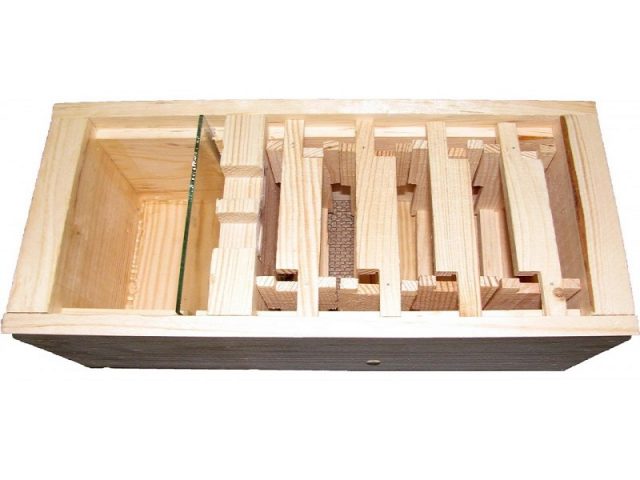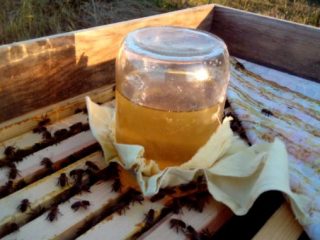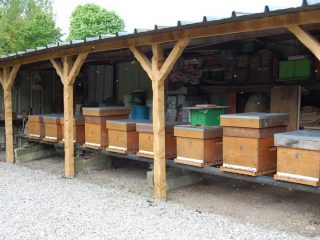Content
Often beekeepers are faced with a problem when it is necessary to insert a fertile uterus into a queenless colony in order to save her. This task is complex, a positive result is not guaranteed, since it depends on objective and subjective factors - methods of carrying out the procedure, the condition of the uterus, the bee colony, and weather conditions.
External factors for replanting queens
To successfully plant a queen bee, a number of external conditions are necessary:
- warm, sunny, windless weather;
- the presence of a good bribe, in which the bees are calm and busy;
- spring or summer is the most favorable season for receiving a queen bee;
- evening time.
Condition of the bee colony before replanting the queen
The result of adding a queen bee to a queenless colony largely depends on the condition of the latter.Replacement is easier if the queen was lost (or removed) only 2 - 3 hours ago. During this time, aggressiveness and anxiety in the hive decrease somewhat. A longer “orphan” state is a negative factor, since in the presence of open brood, fistulous queen cells will be formed. The beekeeper will have to remove them, and only 2 hours after that try to replant the queen. In this case, the family is quite aggressive and may not accept her.
If a queenless bee colony remains as such for quite a long time and humans do not interfere, then tinders appear. Further efforts to plant the young queen are unsuccessful.
In the presence of open brood, the young fertile uterus takes root better. The presence of eggs and larvae is considered a plus.
If there is no brood, it is worth replanting infertile queens. The beekeeper's behavior during the procedure should be calm. You should not delay the inspection of the family, knock on the hive, irritating the insects and causing vicious behavior. Beekeepers noticed that young bees are more calm and friendly towards the new queen than older individuals.
Condition of the queen bee at the time of transplantation
The queen is well received and easy to replant when she is fertile, transplanted from a bee colony where she has just laid eggs. The fetal uterus, which had a break in egg-laying, becomes puny in appearance and excessively mobile. Her appearance is more reminiscent of a barren individual. For this reason, it is difficult to accept. The ideal option is to implant a uterus that you have grown yourself and transfer it directly from the honeycomb.
A barren woman is accepted worse than a fertile woman. To facilitate the process, such a queen should be used immediately after emerging from the queen cell, when it moves smoothly and slowly.
If the queen bee has been sitting in the cage for several days, then she can only be replanted in the nucleus and with great care.
It is very important not to introduce foreign odors along with the cage. The beekeeper's hands should not smell of cologne, onions, or tobacco. Otherwise, the attitude towards the uterus will be hostile and it may be destroyed. It is worth applying honey to the cell from the nest where you want to place the queen.
When can queen bees be replanted?
The older the queen bee, the more drone eggs she lays. The colony's tendency to swarm increases. Honey production is falling. It makes no sense to keep the queen for more than two years; it is worth adding a young one. It is necessary to maintain strict records and registration of replacement queens.
Unplanned replacement occurs for several reasons:
- in case of low family productivity;
- when the winter is poorly tolerated (a large amount of death, diarrhea);
- physical trauma;
- to change the gene pool (insects have become too aggressive);
- to replace the breed;
- in case of illness in the hive.
After the spring inspection, you need to make notes about the strength of the bee colonies, the condition and origin of the queen. Queen bees can be replanted throughout the season as the nucs appear. Constant replacement leads to their high productivity, the appearance of brood until late autumn, which contributes to successful wintering.
To increase the bribe in June or July, you can add a young queen. She cannot lay eggs yet, there is no open brood, honey is being collected. The removed queen is located in a nucleus used for autumn or spring strengthening of bee colonies.
Replanting methods
When the queen ages, dies, is injured, or is unable to lay offspring, the bees independently raise a queen, feeding the larva not with honey, but with milk. The young individual or the bees themselves destroy the old queen and a natural “silent replacement” occurs.
There is a simplified artificial way to replace the queen. It is used in large apiaries, where there is not enough time for labor-intensive methods. Its essence is to add a queen to bee colonies without searching for the old one. To do this, during the bribe, it is necessary to place the printed queen cell in the nest where replacement is required. It is attached between the bars of the frames in the upper body or in the store. The next day, the queen cell is inspected: if not touched, the queen is accepted. If the bees have chewed it up, they put a second one. When the destruction is repeated, it becomes clear that the old queen bee has been selected. If a young one is accepted, then after some time it will emerge from the queen cell and destroy the old one.
Among the main methods of replanting:
- orphan method;
- container method;
- using a cap;
- by layering or nucleus.
All methods can be divided into two groups:
- straight;
- indirect.
Indirect
This method consists of isolating the queen from the bees using mechanical devices at the time of replanting her. Special devices can be in the form of caps and cages, insulating containers, etc.
Using Titov's uterine cell
Many beekeepers try to replant the queen using this method. First you need to remove the old one. Place the young fetus in a cage, attaching it in the center of the nest next to the open brood, directly to the comb. Honey should be in the feed compartment of the cage. Release the queen after 3 days, having previously removed all fistulous queen cells from the nest.If insects react aggressively to the “captive”, then it must again be placed in a cage for 2 days, and the exit must be sealed with wax. Release again after 3 days. The probability of implantation in this way is about 85%, but the disadvantage is the possibility of injury to the uterus, which is in unnatural conditions.
How to plant using a mesh cap
At the end of the day, the queen should be removed from the bee colony. After 4 hours, cover the new queen on the honeycomb with a cap and place it in the center of the nest. In a few days she will begin to lay eggs. It is necessary to remove all fistulous queen cells and the cap, observing the behavior of the bees. If they become aggressive, it is worth extending the queen’s “imprisonment” for another 2 days.
Straight
In this risky method, the queen is placed in the hive without mechanical means of protecting her. This method is relevant in a number of cases:
- when replacing an old one with a new one that does not have a break in egg laying;
- with a large number of fetal uteruses;
- when the bee colony grows intensively.
Among the direct methods, the most famous are:
- using a tap hole – the queen, coated with drone pulp, is launched into the hive;
- replacement — find a queen in the nest, destroy it and place a new one in its place, monitoring its condition for some time;
- shaking off – remove the old queen bee, and add a new one to the bees launched into the hive through the gangway (shake a couple of frames from the hive);
- with cores – the old one with several frames is removed, and the nucleus is placed in the hive, partitioned with an insert board;
- aroma addition – the old queen is destroyed, and the bees and the new one are treated with sweet syrup with mint;
- using ethyl ether (7 drops) – it is applied to the top bar of the frames, covered with canvas, and the queen bee is launched into the center of the nest.
How to add a queen to a hive
For a successful replacement, a number of factors must be taken into account:
- the optimal time for changing the queen is from April to June;
- the best place is for small growing families;
- to accept a queen, it is necessary to remove infertile queens, open brood, eggs and larvae;
- it is difficult to replant the queen after the main honey harvest (July-August) due to the aggressiveness of insects;
- it is easier to correct a queenless colony in August-October, since aggressiveness subsides;
- it is difficult to plant the queen during a period of possible theft;
- bees that are in a pre-swarm state will not accept the new queen, because they choose her themselves during this period.
How to introduce a pregnant uterus into a family
Insects' sense of smell allows them to smell the queen bee's enzymes. They distinguish fertile from infertile ones by smell and accept the former more easily.
One of the ways to replant is from a transfer cell. Breeding bee farms sell queen bees in plastic containers consisting of two compartments. The first is for the queen and her retinue, the second is for the kandi. The top of the container is covered with film. To replant the fetal uterus into the layering from the transfer cell, you must:
- Find and remove the queen bee from the nest.
- Make several holes with a diameter of 2 mm in the film.
- Attach the container with the new queen to the nesting frame next to the brood.
- Close the hive lid.
- After 2 days, inspect the hive and remove the fistulous queen cells.
- Holes covered with wax mean that they do not want to accept the uterus; you should leave the container in its original form for a day.
- If the holes are open, then the film is replaced with wax.
- Place the cage in its original place.
- The bees will gnaw through the foundation and free the captive.
- After three days it is necessary to inspect the nest. If there is seeding, then it was possible to replant - the queen is accepted.
How to transplant a barren uterus
When the queen is replaced with a barren one, the bees react very excitedly. Replanting has a negative impact on productivity. This operation should be carried out on a small layer located in a separate hive or enclosure:
- A barren uterus or queen cell is placed in the layering. It should be placed between frames with brood.
- After fertilization and the start of sowing, strengthen the layering with printed brood.
- Form a layer in the second body of the hive, adding a second plywood bottom to it.
- Add 2 frames with beebread and honey, 2 frames with printed brood, shake off young bees from two frames, place a barren queen and a queen cell.
- Open the spare entrance.
- After the start of sowing, reinforce the layering with frames with printed brood (3 pcs.).
- Remove the old uterus.
- Remove the partition.
- Replaced queens are placed in nuclei for the autumn strengthening of the main families.
How to add a queen to a hive if there is no brood
In order to form layering without brood, you must:
- Place one frame with food and three with freshly built foundation in the nest.
- Close the entrance tightly.
- Shake a few frames of bees into the hive.
- Do not allow the replanting of a queen bee from an old colony.
- Close the hive.
- Move the house to another location.
- Place the barren queen through the entrance.
You can form layering without brood in another way:
- Shake 4 frames of bees into an empty box.
- Cover the ventilation hole with mesh.
- Place the box in the shade.
- Prepare a house with 4 frames.
- Place the queen in the center of the nest in a cage with a hole sealed with wax.
- Shake the bees out of the box and into the hive.
- Close the lid and leave it alone for a day.
- Open the entrance and remove the cage.
How to introduce a queen into a queenless family through a newspaper
The new queen is not well received by the large families. To avoid aggression, you can plant it in the layering using a Titov cell. 3 - 4 days after the queen has been adopted by the layer and begins to sow eggs, you can begin to unite. For this purpose, place a compartment with a layer and a young queen on the main body, separating them with newspaper. The bees will chew through the newspaper and a union will occur. If there is an old one, a fight with the young and strong one is inevitable. Most likely, the young one will win.
How to add a queen to a hive in late autumn
Many beekeepers are afraid to replant the queen bee in September. Nevertheless, this process has many advantages:
- maximum egg production is achieved in April-May;
- no swarming;
- the amount of mother substance is maximum;
- probability of swarming with an autumn queen – 2%;
- increase in apiary profitability;
- reducing the incidence of varroatosis;
- autumn queen bees tolerate wintering better;
- increase in apiary productivity by 50%.
The autumn replanting method is as follows:
- Hang the cage with the queen on a nail driven into the nest feeder.
- Open two holes in the cage.
- Insects pass through the cage for food and release the queen bee.
The whole process takes no more than a day. Interested in the syrup, the insects ignore the queen, who begins to smell of bees rubbing against her. As a result, the replanting is successful and quick.
Working with bees after replanting
For those involved in beekeeping, replanting queen bees is an important and painstaking stage in apiary maintenance. This manipulation is carried out at any time as soon as defects or delays in the development of the family are identified.To be able to cull and replant queen bees, it is necessary to promptly form layers from strong, productive colonies. Replacement queens should be used in nucs to strengthen families in the autumn or spring. They are used on average for two seasons. The first is in the main family and the second is in the nucleus. If during the bribe there is no need for a break in egg laying, then the fertilized uterus is transplanted. If such a break is necessary, then the nuclei are not created, and the queen cells appear later, at the beginning of the bribe.
Conclusion
For the successful operation of the apiary, you need to know how to correctly and on time introduce a fertile uterus into a queenless family. Knowledge and application of not one, but several methods can provide a large volume of honey collection and the health of the apiary. Using knowledge and relying on objective factors, the beekeeper can count on significant work results.

















